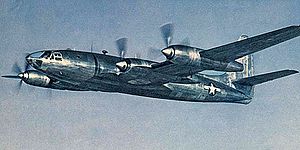Republic XF-12 Rainbow
| XF-12 Rainbow | |
|---|---|
 |
|
| XF-12 Rainbow in flight c. 1947 | |
| Role | Strategic aerial reconnaissance |
| National origin | United States |
| Manufacturer | Republic Aviation |
| First flight | 4 February 1946 |
| Retired | June 1952 |
| Status | Cancelled |
| Primary user | United States Army Air Forces |
| Number built | 2 |
| Unit cost |
$1.25 Million (1946 Dollars)
|
The Republic XF-12 Rainbow was an American four-engine, all-metal prototype reconnaissance aircraft designed by the Republic Aviation Company in the late 1940s. Like most large aircraft of the era, it used radial engines—in this case, the Pratt & Whitney R-4360 Wasp Major. The aircraft was designed with maximum aerodynamic efficiency in mind. The XF-12 was referred to as an aircraft that was "flying on all fours" meaning: four engines, 400 mph cruise, 4,000 mile range, at 40,000 feet. It is still the fastest piston-engined airplane of this size, exceeding by some 50 mph the Boeing XB-39 of 1944. Although highly innovative, the postwar XF-12 Rainbow had to compete against more modern jet engine technology, and did not enter production.
The original proposal for the aircraft, delivered in late 1943, came from the USAAC Air Technical Service Command, stationed at Wright Field. The proposal was for a reconnaissance aircraft which included a requirement for speed (400 mph), ceiling (40,000 ft) and range (4,000 nmi). Its primary objective was for high-speed overflights of the Japanese homeland and key enemy installations. During World War II, due to the extended range requirements of operating in the Pacific, existing fighters and bombers were being used for missions for which they were never intended. The need existed for an aircraft specifically designed for the photo-reconnaissance mission. The aircraft required adequate speed, range and altitude capabilities for its missions to be successful.
In August 1943, U.S. President Franklin D. Roosevelt's son, Colonel Elliot Roosevelt, commander of the F-5 (modified P-38) "recon" unit, recommended the acquisition of a dedicated high-performance photo reconnaissance aircraft, capable of providing pre-strike target acquisition and photo interpretation. Followed by additional overflights to provide post-strike analysis of their subsequent destruction, this would give commanders the ability to make pivotal strategic decisions and set up subsequent raids. The XF-12 was Republic Aviation's attempt to meet those goals. Its primary competition during this time was the Hughes XF-11. Both were introduced at the same time, and both were powered by the new P&W R-4360. The XF-12's first flight was made on 4 February 1946. During the XF-12's subsequent flight testing and development period, it demonstrated the capability of operating at 45,000 feet (14,000 m), at a speed of 470 mph (760 km/h), over a range of 4,500 mi (7,200 km), so it met and exceeded the design goals for which it had been designed. Neither the XF-11 or the XF-12 was purchased in any quantity by the U.S. Army Air Forces (two each), as their need evaporated after hostilities ended in World War II.
...
Wikipedia
